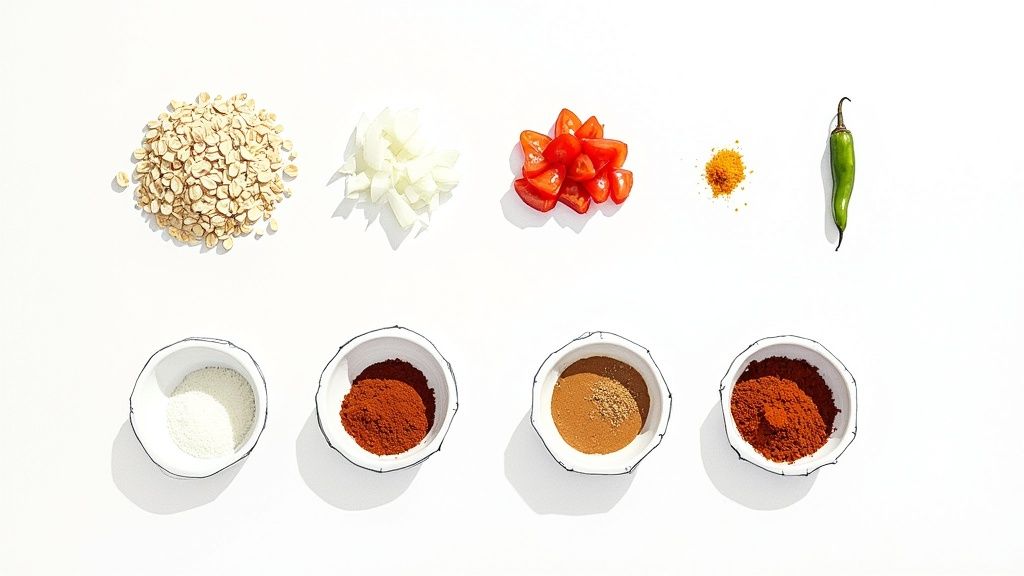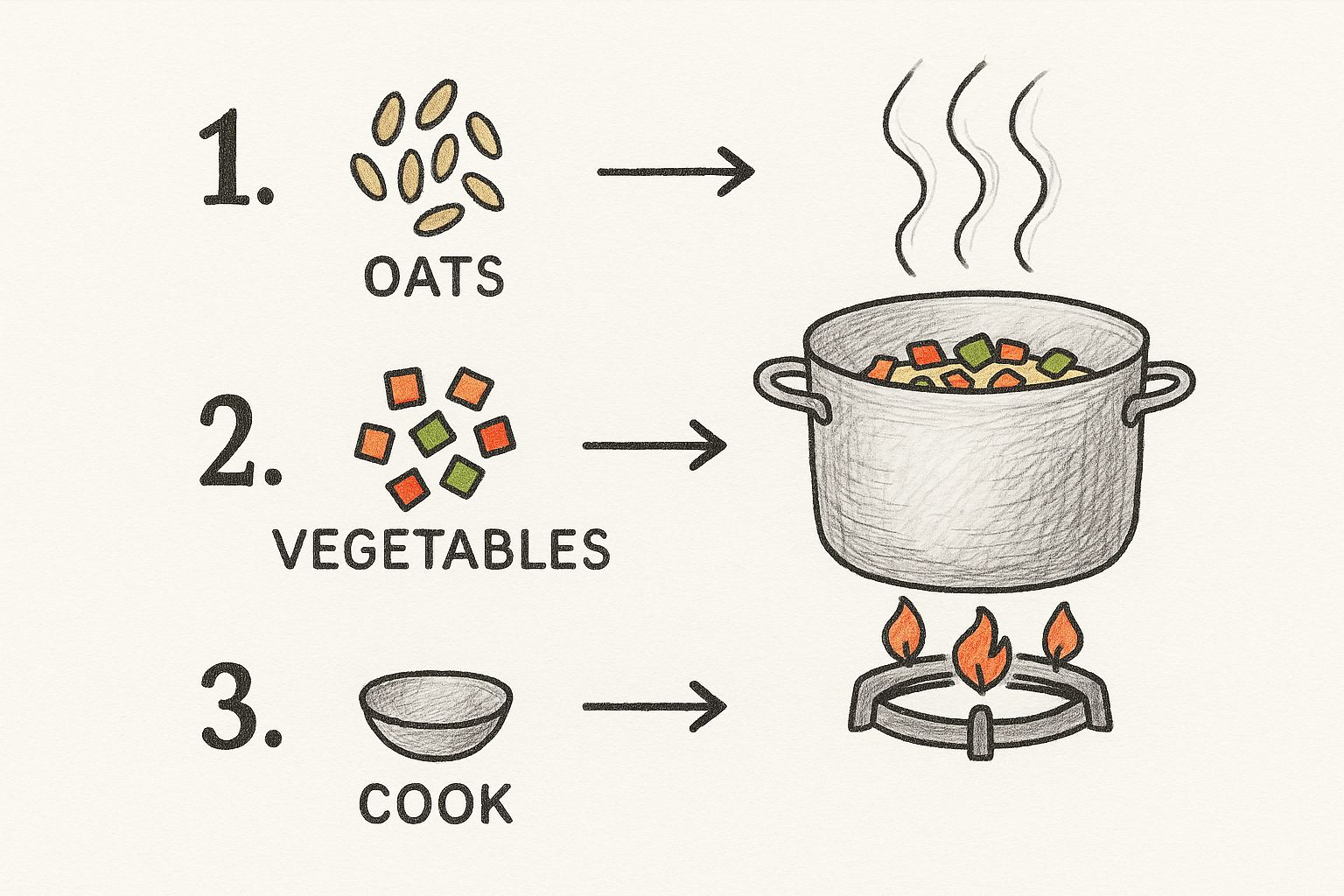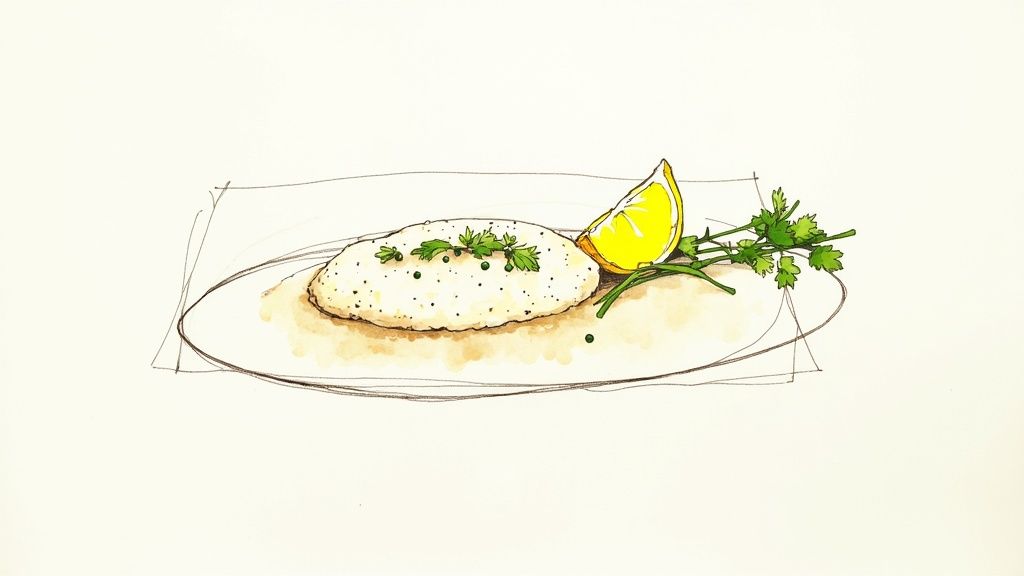A Healthy and Quick Oat Upma Recipe
Discover an easy and healthy oat upma recipe for a delicious breakfast. A quick Indian dish perfect for busy mornings and simple to log with munchlog.ai.
Posted by
Tired of the same old breakfast routine? Let me introduce you to oat upma—a savory, satisfying, and surprisingly quick way to start your day. It’s a simple twist on a classic Indian dish that swaps traditional semolina for fiber-rich oats, creating a warm, flavorful breakfast that's actually good for you.
Your New Favorite Healthy Breakfast
If you're craving something that isn't another sweet cereal or piece of toast, oat upma is the answer. Think of it as a modern, health-conscious spin on the traditional South Indian upma. This simple swap to oats has become popular for a reason—it packs a serious nutritional punch without feeling like "health food."
So, what makes oats a great choice here? They're loaded with good stuff that keeps you full and energized for hours.
- Dietary Fiber: This is key for good digestion and helps you feel satisfied long after you've finished eating. No more mid-morning snack attacks.
- Plant-Based Protein: Essential for muscle repair and keeping your body strong.
- Complex Carbohydrates: These provide a slow, steady release of energy, so you can avoid that crash you get from sugary breakfasts.
According to the United States Department of Agriculture (USDA), just 100 grams of raw oats contain about 16.9 grams of protein and 11.6 grams of dietary fiber. It’s a true powerhouse ingredient. If you want to dive deeper, you can check out these insights on healthy breakfast options.
More Than Just a Recipe
Beyond being delicious, this oat upma recipe is about making mindful eating easy and stress-free. It’s the perfect example of a meal that’s both tasty and simple to track. After you've cooked, you don't have to painstakingly enter every single vegetable and spice into a food diary.
With munchlog.ai, you can just say, "I had a bowl of homemade oat upma," and the app logs an estimate of your calories and macros. It’s a more relaxed way to keep an eye on your nutrition while enjoying food you actually love.
This dish also gives you a real-world look at how different nutrients work. The oats, for instance, are full of complex carbs, which are crucial for sustained energy. If you're curious about that, our guide on what complex carbohydrates are and see more examples is a great place to learn more. With this recipe, healthy eating feels less like a chore and more like a simple, delicious part of your daily life.
What You'll Need to Make Perfect Oat Upma
Before we even think about turning on the stove, let's get all our ingredients in order. I've found that doing a little prep work first—what the chefs call mise en place—makes the whole cooking process smooth and enjoyable. No more frantic searching for cumin seeds while your onions are about to burn!
Having everything chopped and measured also makes logging your meal much easier later. If you use a tool like munchlog.ai, a simple voice command like, "I had my homemade oat upma," will give you a super accurate nutritional picture because you know exactly what went into the pan.

Core Components for This Recipe
I like to think about the ingredients in three main groups: the base, the veggies, and the aromatics that make the dish sing.
- The Base: We're using rolled oats for this. They have a fantastic, slightly chewy texture and won't turn to mush like instant oats can. It makes a huge difference in the final dish.
- The Veggies: A classic trio of onion, carrots, and green peas gives the upma a wonderful sweetness, color, and texture. Feel free to get creative here—diced bell peppers or corn work great too.
- The Aromatics: This is where the magic happens. A classic South Indian tadka or tempering of mustard seeds, cumin seeds, fresh curry leaves, and green chilies builds an incredible foundation of flavor.
My Pro Tip: Don't skip the fresh curry leaves if you can find them. Their unique, savory aroma is what makes this dish taste truly authentic. They're a game-changer.
Oat Upma Ingredients Checklist
To make your trip to the grocery store (or your pantry) a bit easier, here’s a quick checklist of everything you’ll need.
| Ingredient | Quantity | Notes (e.g., 'chopped', 'optional') |
|---|---|---|
| Rolled Oats | 1 cup | Quick-cooking works in a pinch, but avoid instant oats |
| Water | 1.25 cups | You might need to adjust this slightly |
| Onion | 1/4 cup | Finely chopped |
| Carrots | 1/4 cup | Finely chopped |
| Green Peas | 1/4 cup | Fresh or frozen are both fine |
| Neutral Oil | 2 tbsp | Coconut oil is a fantastic, flavorful option |
| Mustard Seeds | 1 tsp | Essential for the tadka |
| Cumin Seeds | 1 tsp | Adds an earthy warmth |
| Curry Leaves | 7-8 leaves | A must-have for authentic flavor |
| Green Chilies | 1-2 | Chopped; use more or less depending on your heat preference |
| Ginger | 1/2 tsp | Finely chopped or grated |
| Salt | To taste | Start with about 1/2 tsp and adjust |
| Coriander Leaves | 1-2 tbsp | For garnish; chopped |
| Lemon Juice | 1 tsp | Adds a bright, fresh finish at the end |
With all your ingredients ready to go, you're all set to start cooking.
How to Make Oat Upma
Alright, let's get into the kitchen and make some oat upma. I find this recipe is less about following strict rules and more about feeling your way through it. The whole thing comes together in under 20 minutes, and the smell as the spices hit the hot pan is just incredible.
First, we're going to toast the oats. This is a simple but crucial step that gives them a lovely nutty flavor and, more importantly, keeps the final dish from turning into mush. From there, we’ll create the tadka, or tempering, which is where the real magic begins.
Once the spices are fragrant, we’ll toss in the vegetables, cooking them just enough to keep a bit of bite. Then it all comes together in one pan, creating a fluffy, savory bowl of goodness that's perfect for a busy morning.
A Walkthrough of the Process
Cooking is all about building layers of flavor. Here’s how we'll do it, moving from one step to the next to create a delicious and balanced dish.
Toast Your Oats: Grab a dry pan and set it over medium heat. Add the rolled oats and stir them around for 3-4 minutes. You're just looking for a light toastiness and a wonderful nutty aroma—don't let them get too brown. Once they're ready, just tip them into a bowl and set them aside.
Create the Tadka (Temper the Spices): In that same pan, heat up your oil. Toss in the mustard seeds and listen for them to start popping. That’s your cue to add the cumin seeds.
Sauté the Aromatics & Veggies: Now, add your chopped onions, ginger, green chilies, and curry leaves. Sauté for a minute or so until the onions have softened up. Follow that with the carrots and peas, giving them another couple of minutes to cook.
Bring It All Together: Pour in the water, add the salt, and bring everything to a rolling boil. Once it's bubbling, slowly add your toasted oats, stirring gently to combine. Pop a lid on the pan, turn the heat down to low, and let it all cook for about 7-8 minutes. The oats will soak up all that flavorful water and become perfectly tender.
This simple flow is all it takes to get from a few ingredients to a satisfying meal.

As you can see, it's a pretty straightforward process of layering flavors and textures.
My Go-To Method
My trusted method starts with one cup of dry-roasted oats. The tadka of mustard seeds adds flavor while about ½ cup of mixed veggies like carrots and peas adds a good amount of fiber without weighing the dish down.
The best part? The whole thing is done in just 15-20 minutes. It's become my lifesaver on mornings when I need something quick and nutritious. You can explore a similar recipe with this healthy and quick breakfast idea here.
My Personal Tip: Once the upma is cooked, kill the heat but leave the lid on for another 5 minutes. This little trick lets the oats steam and get perfectly fluffy. It really allows all the flavors to settle in and meld together.
To finish, I always add a generous squeeze of fresh lemon juice and a good sprinkle of chopped coriander. This last step really brightens everything up and makes the whole dish sing. Now you're all set to enjoy a bowl of homemade, healthy, and seriously tasty oat upma.
Your Upma, Your Way
Think of this recipe as more of a blueprint than a strict set of rules. The real magic of oat upma is how easily you can adapt it to your taste, your nutritional goals, or simply what’s available in your kitchen.
Sometimes you need a meal that's a bit more substantial, especially after a workout or on a busy morning. Boosting the protein is one of the simplest and most satisfying ways to customize your upma.
The best recipes are the ones that bend to fit your life. Whether you're trying to hit a protein goal or just using up that last bit of bell pepper, this dish should work for you, not the other way around.
For an Extra Protein and Texture Kick
Adding a protein source not only makes the upma more filling but also introduces some great textures. If you're curious about your specific needs, our guide on calculating your daily protein needs is a great place to start.
Here are a few of my favorite additions:
- Paneer or Tofu: I like to pan-fry some cubes until they're golden brown and then stir them in right before serving. It adds a wonderful chewiness.
- Lentils: Tossing a tablespoon of chana dal or urad dal into the hot oil during the tempering step gives you these fantastic little crunchy bits throughout the dish.
- Nuts and Seeds: A handful of roasted peanuts or cashews sprinkled on top is a game-changer. It adds a satisfying crunch and healthy fats that round out the meal perfectly.
Don't Be Shy with the Veggies
Carrots and peas are classic, but don't stop there. This upma is the perfect vehicle for clearing out your vegetable drawer. Finely chopped bell peppers add a splash of color and a subtle sweetness, while corn kernels bring little bursts of juicy flavor.
I’ve even tossed in finely chopped broccoli and cauliflower before—they blend in beautifully and add an extra layer of nutrients.
And the best part? You don't have to stress about tracking these little changes. With munchlog.ai, you can forget about manually logging every ingredient. Just tell it, "I had oat upma with extra peas and peanuts," and the app will handle the rest. It keeps food tracking simple, so you can focus on enjoying a meal that’s truly your own.
How Munchlog AI Makes Mindful Eating Effortless
You've just made a fantastic, healthy bowl of oat upma. So, what's next? This is where the whole mindful eating thing can get complicated, but with munchlog.ai, it becomes second nature. Forget about tedious food diaries or manually plugging in every last ingredient. You just talk.
Seriously, that's it. Once you're done with your meal, you simply say, "I ate a bowl of homemade oat upma." No more hunting through huge food databases or typing on a tiny keyboard. The app's AI gets it, and in return, you get a clear, estimated snapshot of your meal's nutritional info.

Building Nutritional Awareness Without the Stress
Let's be clear: this isn't about getting bogged down in restrictive dieting or obsessing over every single number. It’s about creating a more relaxed, gentle awareness of what you're fueling your body with.
You get a quick glance at the estimated calories, protein, carbs, and fat, which helps you stay connected to your food choices in a much more casual, sustainable way. It's like having a friendly nutritionist in your pocket, without the pressure.
Voice tracking removes the biggest hurdle to sticking with any food log: the sheer effort involved. It's designed to fit seamlessly into your life, not the other way around.
For a lot of us, just understanding how different nutrients balance out is the toughest part. This approach makes it really easy to see how a meal like oat upma fits into your day. It’s a fantastic starting point if you're curious about balancing your meals. If you want to dive a little deeper, we have a simple guide on how to count macros without the headache.
At the end of the day, munchlog.ai is here to help you stay mindful while you continue to enjoy the food you love to cook and eat. It’s a tool that supports your lifestyle, turning nutrition tracking from a chore into a simple, empowering habit.
Got Questions About Oat Upma? I've Got Answers.
Making a new recipe always brings up a few questions. Let's tackle some of the most common ones I hear about this oat upma, so you can cook with confidence.
Can I Use Instant Oats Instead of Rolled Oats?
I really recommend sticking with rolled oats for this one. They have the perfect texture—firm enough to hold their shape and give the upma a satisfying, chewy bite.
Instant oats are much finer and tend to turn to mush almost immediately. You'll lose that classic upma consistency, and it just won't be the same experience.
What's the Best Way to Store and Reheat Leftovers?
Pop any leftover oat upma into an airtight container, and it'll keep well in the fridge for up to two days.
When you're ready to reheat, the key is to add a little moisture back in. Just sprinkle a splash of water over the upma and zap it in the microwave for a minute or so. You can also warm it gently in a pan on the stovetop.
My pro-tip for reheating: After adding that splash of water, use a fork to gently break up the upma. This little step helps it heat through evenly and stops it from getting clumpy.
Is This a Good Recipe for Meal Prep?
Oh, absolutely! Oat upma is a meal prep superstar. I often make a big batch on a Sunday to have on hand for the next few days.
It saves so much time during a hectic week. Portion it out, and you have a fantastic, ready-to-go breakfast or a quick, healthy lunch waiting for you.
Ready to make mindful eating a simple part of your daily life? Try munchlog.ai and see how effortless tracking your meals can be. Start tracking with your voice today at munchlog.ai.